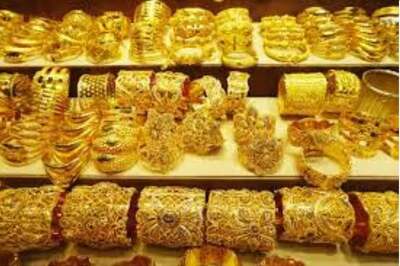
views
Celtic Knot Symbols & Meanings: An Overview
The Celtic knot symbolizes the interconnectedness of life. It’s one of the most recognized Irish symbols including both the Claddagh and the shamrock. The Celts wore and displayed various kinds of knots as symbols of protection, spiritual power, and love, depending on the knot they used. Each Celtic knot type has a particular origin and meaning all its own. Celtic symbols often appeared in art, jewelry, manuscripts, and religious objects. Celtic knot symbols are central to the Book of Kells, a 1,200-year-old illuminated manuscript of the four Gospels and an iconic symbol of Celtic culture.
8 Types of Celtic Knots
Trinity Knot The trinity knot’s 3-sided design stands for the cycles of life, death, and rebirth. It has also been associated with the natural elements of earth, sea, and sky. In addition to these meanings for pagan Celtic civilizations, early Christian Celts used the trinity knot as a symbol for the holy trinity’s 3 parts: Father, Son, and Holy Ghost. Trinity knots are also called the Triquetra, which is based on the Latin word for a triangle.
Dara Knot The Dara knot is a symbol of strength, wisdom, and power. Its name comes from the Irish “doire,” meaning “oak.” Celtic pagans associated the oak tree (and all trees) with doorways that connected the living to the dead. The Dara knot design is meant to look like the intricate roots of an oak tree and is considered a shield knot in Celtic culture.
Love Knot The Celtic love knot represents love in life and eternity. The interwoven knots were a symbol of love that the Celts exchanged when they got married much like people exchange wedding rings today. Its design includes 2 interlocking heart shapes with no beginning or end, and dates back to 2500 BCE.
Solomon’s Knot Solomon’s knot is a symbol of both immortality and love. It consists of 2 interlocking oval shapes that have neither a beginning nor end, like many other Celtic knots and meanings. It dates back to the Stone Age and is associated with King Solomon because it was seen in synagogues in the ancient world. The Celtic Solomon’s knot also appears on ancient Roman floor mosaics throughout the Byzantine period in history. The 2 interlocking oval shapes of Solomon’s knot are also a symbol of love and union and have been compared to the Claddagh ring, which represents love and friendship.
Shield Knot The Celtic shield knot stands for protection, strength, and endurance. It’s a favorite of Celtic warriors who etched the symbol into their weapons and shields during battle. Outside of battle, ancient Celts gave the shield knot symbol as gifts and carved it into doorways to ward off evil spirits and to protect the homes of loved ones. The Celts sometimes etched them into the tombstones of those who passed away and gave them to newborns to protect them until they could protect themselves. The Battersea Shield is one of the most well-known Celtic shield knots and dates back to 350 – 50 BCE. Made of bronze, it appears as 3 Celtic shield knots that surround 27 red glass pieces.
Sailor’s Knot The Celtic sailor’s knot symbolizes protection and fortitude. It’s known for having no beginning or end, which is represented by its interlocking woven lines to visually represent the waves of the sea. Sailors kept and tied Celtic knots as reminders of loved ones who waited for them while they were away at sea for months at a time. Because the Celtic sailor’s knot was a token for family and loved ones, it can stand for eternal love and friendship. Sailor’s knots were also symbols of luck and good fortune and as a talisman for protection while sailing on the high seas.
Spiral Knot The Celtic spiral knot stands for the idea of eternal life. The number 3 figures heavily in many Celtic knot designs; here it can represent the 3 stages of life (life, death, afterlife), 3 domains of earth (land, water, air), and 3 passages of time (past, present, future). The spiral knot is made up of one continuous line to signal continuity, while the spirals are signs of growth and transformation.
Celtic Cross The Celtic cross is a symbol of the Holy Trinity. Others link it to a more traditional pagan meaning of the 3 female archetypes: maiden, mother, and crone. It dates back to between the 5th and 8th centuries of the Middle Ages and features an endless interlacing knot at the center of a 4-pointed cross. The circular shape in the center of the cross is said to represent Christ’s halo, the sun, or eternity. It’s thought that St. Patrick used the Celtic cross as a symbol to help convert pagan kings to Christianity. It can be seen as a combination of the circular symbol for the pagan sun god and a Christian cross all at once.
A Guide to Getting a Celtic Knot Tattoo
Celtic knot tattoos primarily symbolize eternity and unity. The coming together of the divine and moral are represented by an overall theme of spiritual transformation. Getting a Celtic knot tattoo is a bold way to show the world you’re on a unique journey all your own. It’s also a popular way to show Irish pride for your Celtic heritage. The color you choose for your Celtic knot tattoo can vary. Blue is associated with healing, while white stands for purity, red for courage, and green for money and fertility. Among Celtic knot tattoo symbols, the love knot, the sailor’s knot, and Solomon’s knot are all linked to love and friendship. If you’re looking to honor your significant other, good friend, or family member, these are your best choices.
Celtic Knot Meaning FAQs
Can anyone wear Celtic knots? You do not have to have Irish heritage to wear a Celtic knot design. Anyone who connects to the meanings behind Celtic knots can connect to them spiritually. It’s also quite common for those with Irish or Celtic ancestry to wear Celtic knots as a sign of pride for their heritage; this is especially true of Celtic crosses, which are considered one of many Druid symbols.
What does the 3-point Celtic Knot mean? The 3 -point Celtic knot is called the Trinity knot or the Triquetra, which means “3-sided.” Its 3 interlocking shapes stand for unity, protection, and everlasting life. It’s also a symbol of strength that is associated with the Holy Trinity in Christianity of the father, son, and Holy Spirit.
Is the Celtic Knot Scottish or Irish? Most Celtic knot designs can be either Irish or Scottish. The Celtic culture came to the British Isles around 1,000 BCE and today is woven into the cultures of Ireland, Scotland, Wales, and certain areas of England. Celts are also a big part of the history of Breton culture, found on the northwest coast of France in Brittany. Celtic knot designs have appeared in multiple locations, but are the most associated with Ireland today.


















Comments
0 comment